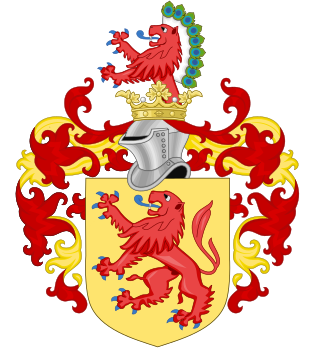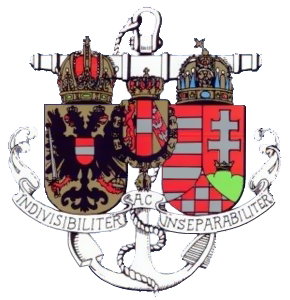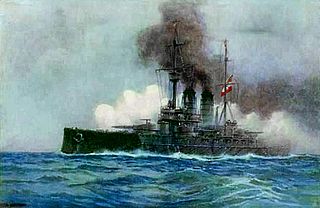
The House of Habsburg, also known as the House of Austria, was one of the most prominent and important dynasties in European history.

The Low Countries, historically also known as the Netherlands, is a coastal lowland region in Northwestern Europe forming the lower basin of the Rhine–Meuse–Scheldt delta and consisting today of the three modern "Benelux" countries: Belgium, Luxembourg, and the Netherlands. Geographically and historically, the area can also include parts of France and the German regions of East Frisia, Guelders and Cleves. During the Middle Ages, the Low Countries were divided into numerous semi-independent principalities.

SMS Zrínyi was a Radetzky-class semi-dreadnought battleship (Schlachtschiff) of the Austro-Hungarian Navy, named for the Zrinski, a Croatian-Hungarian noble family. Zrínyi and her sisters, Erzherzog Franz Ferdinand and Radetzky, were the last pre-dreadnoughts built for the Austro-Hungarian Navy.

The emperor of Austria was the ruler of the Austrian Empire and later the Austro-Hungarian Empire. The hereditary imperial title and office was proclaimed in 1804 by Francis II, Holy Roman Emperor, a member of the House of Habsburg-Lorraine, and continually held by him and his heirs until Charles I relinquished power in 1918.

Archduke was the title borne from 1358 by the Habsburg rulers of the Archduchy of Austria, and later by all senior members of that dynasty. It denotes a rank within the former Holy Roman Empire (962–1806), which was below that of Emperor, and roughly equal to King, Prince-Archbishop, and Grand prince, but above that of a Grand Duke, Sovereign Prince, and Duke.

The Habsburg monarchy, also known as Habsburg Empire, or Habsburg Realm, was the collection of empires, kingdoms, duchies, counties and other polities that were ruled by the House of Habsburg. From the 18th century it is also referred to as the Austrian monarchy or the Danubian monarchy.

The Austro-Hungarian Navy or Imperial and Royal War Navy was the naval force of Austria-Hungary. Ships of the Austro-Hungarian Navy were designated SMS, for Seiner Majestät Schiff. The k.u.k. Kriegsmarine came into being after the formation of Austria-Hungary in 1867, and ceased to exist in 1918 upon the Empire's defeat and subsequent collapse at the end of World War I.

The Kingdom of Hungary between 1526 and 1867 existed as a state outside the Holy Roman Empire, but part of the lands of the Habsburg monarchy that became the Austrian Empire in 1804. After the Battle of Mohács in 1526, the country was ruled by two crowned kings. Initially, the exact territory under Habsburg rule was disputed because both rulers claimed the whole kingdom. This unsettled period lasted until 1570 when John Sigismund Zápolya abdicated as King of Hungary in Emperor Maximilian II's favor.
Habsburg Hungary may refer to:

The House of Habsburg-Lorraine originated from the marriage in 1736 of Francis III, Duke of Lorraine and Bar, and Maria Theresa of Austria, later successively Queen of Bohemia, Queen of Hungary, Queen of Croatia and Archduchess of Austria. Its members are the legitimate surviving line of both the House of Habsburg and the House of Lorraine and inherit their patrimonial possessions from their female line of the House of Habsburg and from the male line of the House of Lorraine.

The Austro-Hungarian Armed Forces or Imperial and Royal Armed Forces were the military forces of Austria-Hungary. It comprised two main branches: The Army (Landstreitkräfte) and the Navy (Kriegsmarine). Both of them organised their own aviation branches – the Army's Aviation Troops and the Navy's Naval Aviation. The Army in turn consisted of its own three branches: The Common Army, the Imperial-Royal Landwehr and the Royal Hungarian Honvéd.

SMS Árpád was a pre-dreadnought battleship built by the Austro-Hungarian Navy in the early 20th century. She was launched on 11 September 1901 as the second of three Habsburg-class battleships. Along with her sister ships, she participated at the bombardment of Ancona during World War I. Due to a shortage of coal, she was soon decommissioned after the bombardment of Ancona and used as harbor defense ship for the remainder of the war. After the war, all of the Habsburg-class battleships were ceded to Great Britain as war prizes. She was scrapped in Italy in 1921.

SMS Habsburg was a pre-dreadnought battleship built by the Austro-Hungarian Navy in 1899. The lead ship of the Habsburg class was launched on 9 September 1900. In 1903 and 1904, Habsburg and her sister ship Árpád conducted training exercises in the Mediterranean Sea. In 1906 and 1907, Habsburg was transferred to the III Battleship Division. One of her superstructure decks was removed to reduce weight and to modernize the vessel in 1910.

SMS Erzherzog Franz Ferdinand was an Austro-Hungarian Radetzky-class pre-dreadnought battleship commissioned into the Austro-Hungarian Navy on 5 June 1910. She was named after Archduke Franz Ferdinand. The first ship of her class to be built, she preceded Radetzky by more than six months. Her armament included four 30.5 cm (12 in) guns in two twin turrets, and eight 24 cm (9.4 in) guns in four twin turrets.

The Monarch class was a class of three coastal defense ships built by Austria-Hungary at the end of the 19th century. The Monarchs were the first ships of their type to utilize turrets. The class comprised three ships: SMS Monarch, SMS Wien, and SMS Budapest, each armed with four 240 mm (9 in) L/40 guns in two turrets and capable of 15.5 knots at full speed. Budapest was fitted with slightly more modern and powerful engines, giving her a top speed of 17.5 knots.

The grand title of the emperor of Austria was the official list of the crowns, titles, and dignities which the emperors of Austria carried from the foundation of the empire in 1804 until the end of the monarchy in 1918.

The 24 cm Schnelladekanone Länge 40, abbreviated as 24 cm SK L/40, was a German naval gun developed in the years before World War I that armed a number of the Imperial German Navy's pre-dreadnought battleships and armored cruisers. Later; a number of these guns were removed from naval ships and converted to coastal artillery; which would see service during World War I and World War II. The actual bore diameter was 23.8 cm (9.4 in), but the classification system for artillery rounded up to the next highest centimeter.
Lothringen, or Lorraine, is a region of northeastern France.















